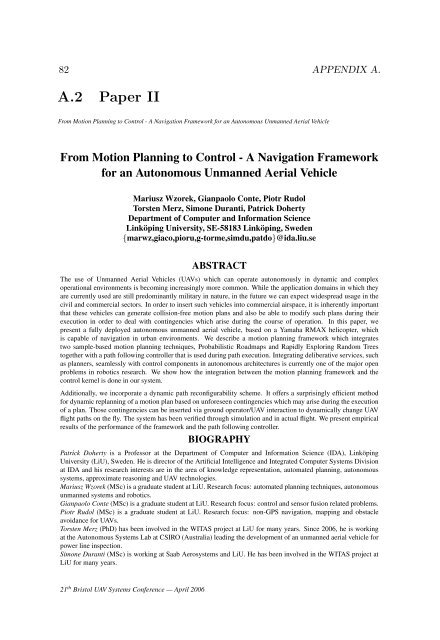Navigation Functionalities for an Autonomous UAV Helicopter
Navigation Functionalities for an Autonomous UAV Helicopter
Navigation Functionalities for an Autonomous UAV Helicopter
Create successful ePaper yourself
Turn your PDF publications into a flip-book with our unique Google optimized e-Paper software.
82 APPENDIX A.<br />
A.2 Paper II<br />
From Motion Pl<strong>an</strong>ning to Control - A <strong>Navigation</strong> Framework <strong>for</strong> <strong>an</strong> <strong>Autonomous</strong> Unm<strong>an</strong>ned Aerial Vehicle<br />
From Motion Pl<strong>an</strong>ning to Control - A <strong>Navigation</strong> Framework<br />
<strong>for</strong> <strong>an</strong> <strong>Autonomous</strong> Unm<strong>an</strong>ned Aerial Vehicle<br />
Mariusz Wzorek, Gi<strong>an</strong>paolo Conte, Piotr Rudol<br />
Torsten Merz, Simone Dur<strong>an</strong>ti, Patrick Doherty<br />
Department of Computer <strong>an</strong>d In<strong>for</strong>mation Science<br />
Linköping University, SE-58183 Linköping, Sweden<br />
{marwz,giaco,pioru,g-torme,simdu,patdo}@ida.liu.se<br />
ABSTRACT<br />
The use of Unm<strong>an</strong>ned Aerial Vehicles (<strong>UAV</strong>s) which c<strong>an</strong> operate autonomously in dynamic <strong>an</strong>d complex<br />
operational environments is becoming increasingly more common. While the application domains in which they<br />
are currently used are still predomin<strong>an</strong>tly military in nature, in the future we c<strong>an</strong> expect widespread usage in the<br />
civil <strong>an</strong>d commercial sectors. In order to insert such vehicles into commercial airspace, it is inherently import<strong>an</strong>t<br />
that these vehicles c<strong>an</strong> generate collision-free motion pl<strong>an</strong>s <strong>an</strong>d also be able to modify such pl<strong>an</strong>s during their<br />
execution in order to deal with contingencies which arise during the course of operation. In this paper, we<br />
present a fully deployed autonomous unm<strong>an</strong>ned aerial vehicle, based on a Yamaha RMAX helicopter, which<br />
is capable of navigation in urb<strong>an</strong> environments. We describe a motion pl<strong>an</strong>ning framework which integrates<br />
two sample-based motion pl<strong>an</strong>ning techniques, Probabilistic Roadmaps <strong>an</strong>d Rapidly Exploring R<strong>an</strong>dom Trees<br />
together with a path following controller that is used during path execution. Integrating deliberative services, such<br />
as pl<strong>an</strong>ners, seamlessly with control components in autonomous architectures is currently one of the major open<br />
problems in robotics research. We show how the integration between the motion pl<strong>an</strong>ning framework <strong>an</strong>d the<br />
control kernel is done in our system.<br />
Additionally, we incorporate a dynamic path reconfigurability scheme. It offers a surprisingly efficient method<br />
<strong>for</strong> dynamic repl<strong>an</strong>ning of a motion pl<strong>an</strong> based on un<strong>for</strong>eseen contingencies which may arise during the execution<br />
of a pl<strong>an</strong>. Those contingencies c<strong>an</strong> be inserted via ground operator/<strong>UAV</strong> interaction to dynamically ch<strong>an</strong>ge <strong>UAV</strong><br />
flight paths on the fly. The system has been verified through simulation <strong>an</strong>d in actual flight. We present empirical<br />
results of the per<strong>for</strong>m<strong>an</strong>ce of the framework <strong>an</strong>d the path following controller.<br />
BIOGRAPHY<br />
Patrick Doherty is a Professor at the Department of Computer <strong>an</strong>d In<strong>for</strong>mation Science (IDA), Linköping<br />
University (LiU), Sweden. He is director of the Artificial Intelligence <strong>an</strong>d Integrated Computer Systems Division<br />
at IDA <strong>an</strong>d his research interests are in the area of knowledge representation, automated pl<strong>an</strong>ning, autonomous<br />
systems, approximate reasoning <strong>an</strong>d <strong>UAV</strong> technologies.<br />
Mariusz Wzorek (MSc) is a graduate student at LiU. Research focus: automated pl<strong>an</strong>ning techniques, autonomous<br />
unm<strong>an</strong>ned systems <strong>an</strong>d robotics.<br />
Gi<strong>an</strong>paolo Conte (MSc) is a graduate student at LiU. Research focus: control <strong>an</strong>d sensor fusion related problems.<br />
Piotr Rudol (MSc) is a graduate student at LiU. Research focus: non-GPS navigation, mapping <strong>an</strong>d obstacle<br />
avoid<strong>an</strong>ce <strong>for</strong> <strong>UAV</strong>s.<br />
Torsten Merz (PhD) has been involved in the WITAS project at LiU <strong>for</strong> m<strong>an</strong>y years. Since 2006, he is working<br />
at the <strong>Autonomous</strong> Systems Lab at CSIRO (Australia) leading the development of <strong>an</strong> unm<strong>an</strong>ned aerial vehicle <strong>for</strong><br />
power line inspection.<br />
Simone Dur<strong>an</strong>ti (MSc) is working at Saab Aerosystems <strong>an</strong>d LiU. He has been involved in the WITAS project at<br />
LiU <strong>for</strong> m<strong>an</strong>y years.<br />
21 th Bristol <strong>UAV</strong> Systems Conference — April 2006

















